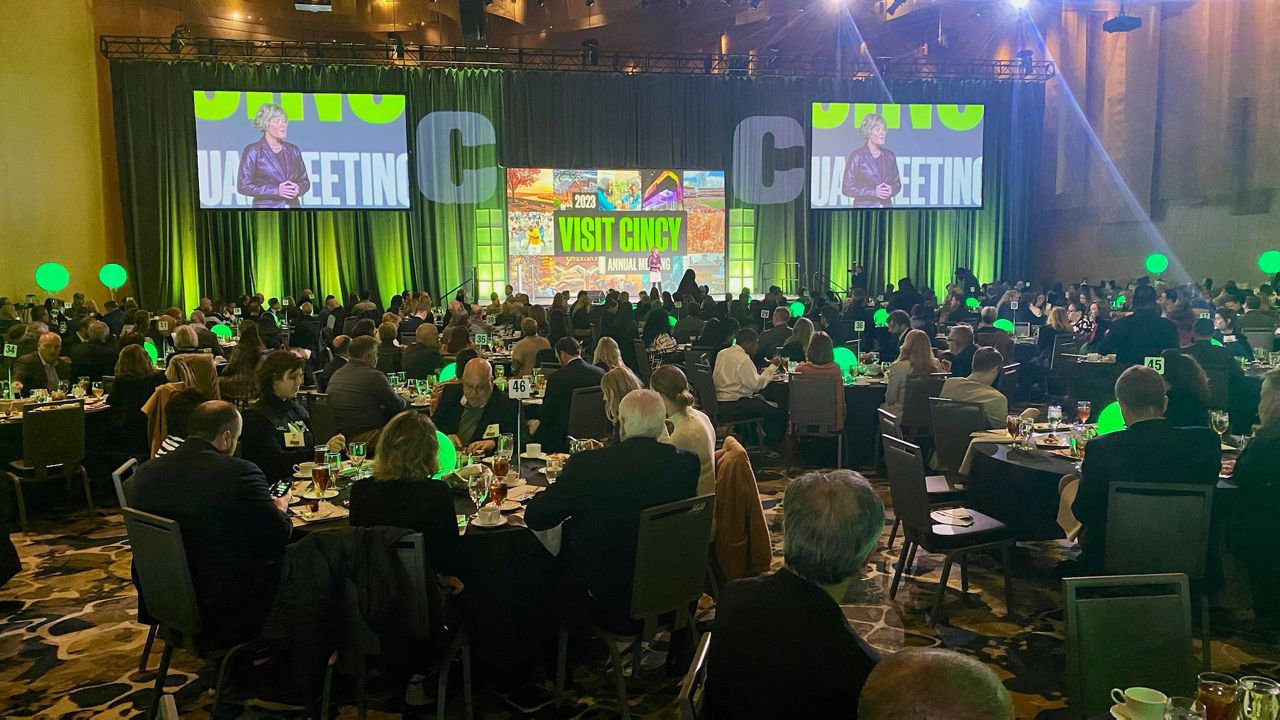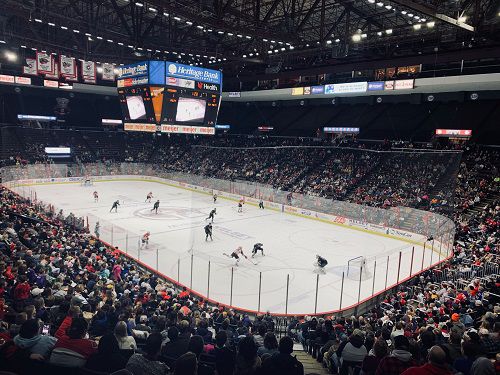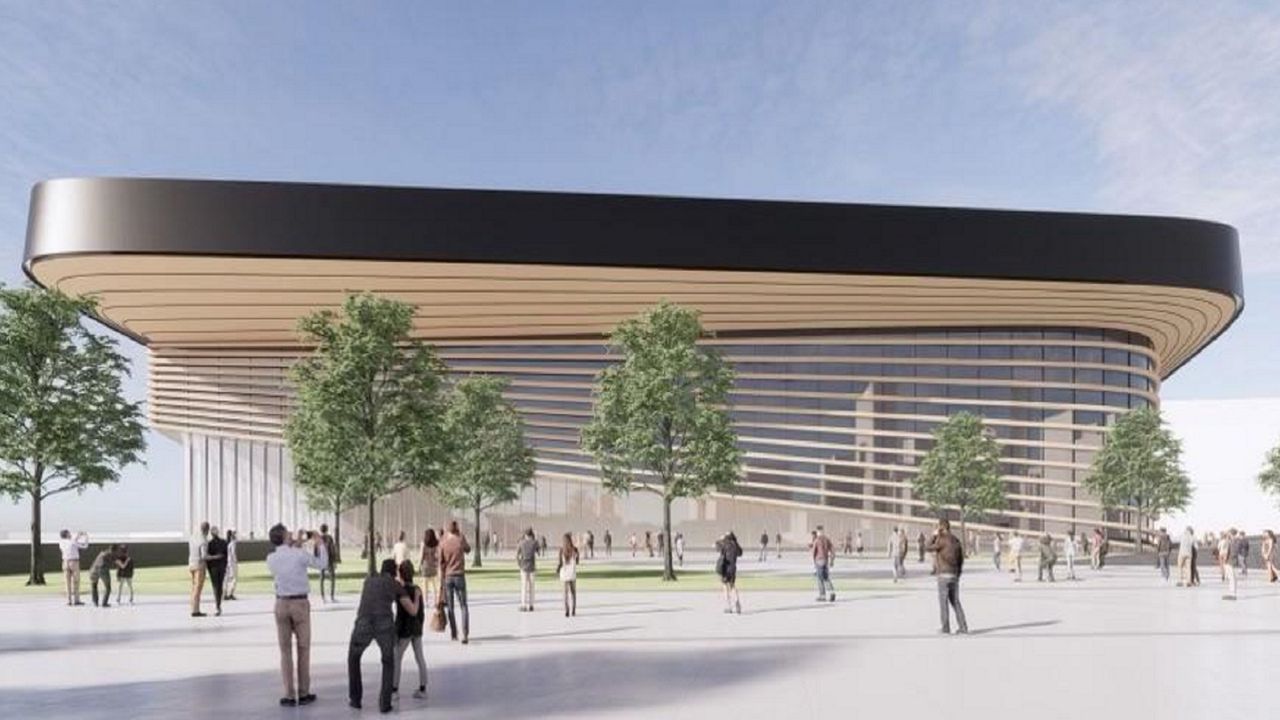CINCINNATI — FC Cincinnati co-CEO Jeff Berding is calling on city and county leaders to support the “urgent” construction of a new arena to replace what he described as an “obsolete hunk of metal down on the river.”
What You Need To Know
- Jeff Berding rekindled discussions about a new downtown arena to replace the 50-year-old Heritage Bank Center
- FC Cincinnati's co-CEO made comments during Visit Cincy's annual meeting
- The new arena aims to build on momentum created by the Duke Energy Convention Center project, which includes a building remodel and a new hotel
- There's isn't a site picked for the proposed arena, and the conversations and planning remain in the very early stages, Berding said
Berding delivered his renewed case for why the region needs to replace Heritage Bank Center during the annual meeting of Visit Cincy, the region’s convention and tourism board.
Other comments made during the luncheon included a show of support for the new companion bridge for the Brent Spence Bridge. He also praised the idea to place a cap over Fort Washington Way to add more green space and better connect The Banks to the rest of downtown.
Visit Cincy CEO Julie Calvert joined representatives from the Cincinnati Bengals to announce the city’s intent to host an NFL Draft by 2029.
But arguably the biggest update dealt with plans for the renovation of the $200 million overhaul of the Duke Energy Convention Center and the construction of a new 800-room headquarter hotel across the street.

Berding, Visit Cincy’s board chair, envisions the arena being near downtown’s rapidly developing Convention Center District.
There are plans for an independent feasibility survey to determine the exact location, Berding said. He expects it to take place within the next year.
“We have some enormously wonderful assets (in Hamilton County), but some of our most important assets are obsolete and they don’t work for us,” Berding said of facilities such as Heritage Bank Center, which was built in 1975. “They hurt us in our efforts to bring major events, to bring visitors here that support (the hospitality and tourism) industry.”
During his nearly 20-minute remarks, Berding voiced a fear that Cincinnati would fall behind other midwestern cities if it doesn’t continue to fund major projects, namely a new state-of-the-art arena.
Heritage Bank Center currently hosts dozens of events per year, ranging from professional wrestling and monster truck rallies to Disney on Ice and concerts by people such as Carrie Underwood. The roughly 346,000-square-foot coliseum can seat about 18,000 people for Cincinnati Cyclones games, the minor-league hockey team that calls it home.
But Berding feels it’s too small and features outdated amenities, such as concessions and bathrooms. He feels the arena has cost the city the ability to host major events, such as the NCAA men’s basketball tournament.
He didn’t put a timeline on the project, but called the need “urgent.”
A new arena would be “much bigger” and more modern than the nearly 50-year-old Heritage Bank Center, Berding said. He compared it to Nationwide Arena in Columbus, but he pointed out that it’s too early in the planning stages for the exact size and scope of the project.
Berding asked the following to the 400 business officials in attendance Friday: If Des Moines, Iowa and Sioux Falls, South Dakota can build arenas, why can’t Cincinnati?
“When we think about all the restaurants and all the hotels, trying to recruit talent to support our companies and the local startup ecosystem, we have to make investments,” he added.
Calvert agreed with Berding’s assessment. She noted Cincinnati has returned or exceeded pre-pandemic levels in areas like conventions and year-round leisure tourism, which she described as “through the roof.”
Visit Cincy data showed the city is lagging slightly behind in hotel-occupancy rates compared to 2019. Calvert attributed it to cuts in business travel. But hotel rate and revenue-per-room figures continue to climb.

To take those efforts to the next level, however, the city needs to build on momentum seen in and around the convention center, Calvert said. She described the region as being at a decision-making crossroads right now.
“These aren’t not just lofty ideas anymore,” she added. “We’ve seen real examples where we can get these things done, such as the convention center, if people come together.”
There’ve been preliminary discussions with elected officials in Cincinnati and Hamilton County and other stakeholder groups for roughly the past two years, Berding said.
Renderings of a potential arena presented during Friday’s event were not a final concept — and the final product may look nothing like it, Berding said. The goal of the drawing was to drive home what Cincinnati could have in a few years.
It’s not yet clear who would pay for the new facility — the city, the county or private dollars. He suggested it could be a combination of all three.
Mayor Aftab Pureval called having a modern arena vital to hosting the biggest national and international events. He feels it’s time for the city to “come together and have a serious conversation about the feasibility of an arena, how to pay for it, and where to put it.”
“This decision has a substantial impact on the growth of our local economy, and now is the right time to talk about it,” he added.
In a statement to Spectrum News, leadership from Heritage Bank Center stressed their support for a new arena and a desire to continue to be part of related conversations. Spokesperson Sean Lynn thanked Berding and Visit Cincy for “bringing these discussions back to the forefront of the public’s mind.”
“The city of Cincinnati is deserving of a new arena,” he added. “As a major market that prides itself in its love of sports and entertainment, the discussions of a state-of-the-art facility are exciting. We are confident that the success of the Cyclones can anchor a new venue and serve as a model tenant.”
Berding reiterated that Friday’s comments were intended to “plant a stake in the ground” to support the building of a new arena. On the heels of the progress made in the Convention Center District, he believes this could be the next big thing.
“We’ve made some really critical investments in the past… and I look forward to being here next year reporting the same level of progress on the arena,” he said.



